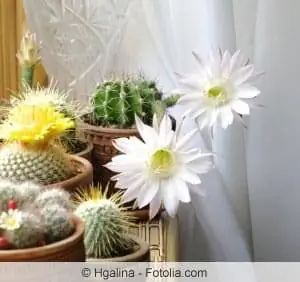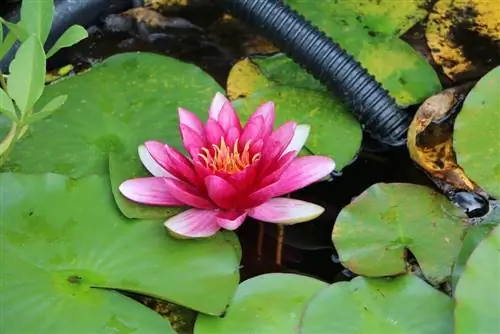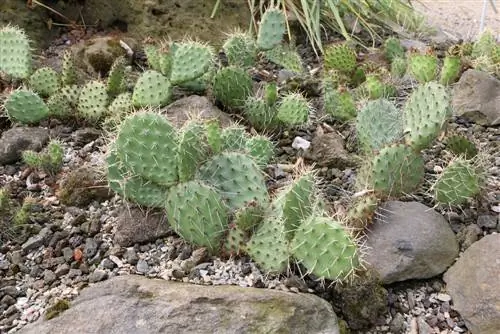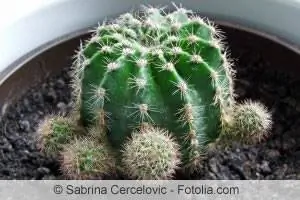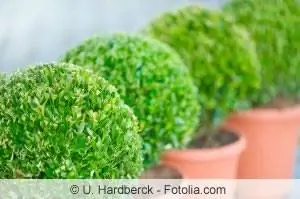- Author admin [email protected].
- Public 2023-12-17 03:39.
- Last modified 2025-01-24 12:45.
A variety of plant genera and species are home to succulents, Mother Nature's succulent masterpieces. What they all have in common is their unique ability to store water, allowing them to thrive in even the most inhospitable conditions. No matter how hot and dry it may be; Succulents enchant with their furious habit and wonderful flowers. The most popular representatives are cacti, closely followed by thickleaf and spurge plants and other representatives. The following instructions explain in practical terms how to properly plant and repot succulents in your garden.
Plants in the bed
Winter-resistant succulents for outdoor cultivation are primarily dependent on soil conditions that match natural conditions. In their homeland, the succulent plants thrive predominantly in humus-poor soil whose mineral components dominate. With regard to the light and temperature conditions, the frost-resistant species and varieties can be planted in all regions of Germany. Even the coldest temperatures of -20 degrees Celsius and lower do not cause them any problems.
Location
As long as you choose the right variety, succulents in the garden will bring you a lot of joy. You can develop your optimum here:
- Sunny to semi-shady location
- Ideally a southern slope
- Humose, well-drained soil
- I would like a combination of clay and sand
Succulents do not value a high nutrient content. They prefer to extend their roots in lean, granular substrate. The rock garden, the dry stone wall or the gravel bed are therefore perfect places to stay for cacti, agaves, sempervivum and colleagues.
Planting time and correct planting
It's open late, the time window for planting. You can plant succulents in the ground from March to August. The only requirement for an early date in the year is frost-free ground. Here's how to do it:
- Thoroughly loosen the soil at the chosen location
- Work in a few handfuls of quartz sand, fine-grained grit or lava granules
- Dig a planting pit with 1.5 times the volume of the root ball
- Create a drainage made of inorganic material on the sole
- Place the succulent in the middle
- Fill the soil so that it is positioned exactly as deep as before
While other perennials are now thirsty for water, succulents are only getting a sip. Ideally, the drought specialists are allowed to establish themselves in the bed for a few days before watering them for the first time. The hunger artists also don't want to be bothered with fertilizer of any composition. Nutrient supply is only included in the care protocol as part of later care.
Tip:
Young succulents have to build up their winter hardiness in the first 2 to 3 years. Until then, they will first be cared for behind glass before being planted out into the open.
Repotting
In the planter, succulents create impressive accents all year round on the balcony, terrace, in the entrance area or at the seating area in the garden. This applies specifically to the cold season, when wintry melancholy takes over the garden. The same applies to species and varieties that develop their natural beauty in indoor cultivation. Since purchased succulents are often found in a completely unsuitable substrate made of nutrient-rich potting soil, experienced hobby gardeners do not neglect to repot them immediately. Follow these instructions to properly use succulents in the pot:
- Choose a planter with a bottom opening for water drainage
- Spread crushed pottery shards or grit over it as drainage
- Use a mixture of equal parts clay, sand and perlite as a substrate
- Optionally use special cactus or succulent soil from specialist retailers
- Fill in the potting soil up to half the height of the pot
- Make a depression in it and place the potted plant in the middle
- Plant the young succulent as deep as before
Since the quality of the substrate is of fundamental importance for the successful cultivation of succulents, it is subjected to a small test before use in the pot. Take a small amount of the mixture in your hand and squeeze it together. The earth is optimally structured if it retains its pressed shape for a short time after opening the hand and then falls apart loosely.
Tip:
The growth rate of succulents defines the time interval at which repotting is necessary. As a rule, the succulent ornamental plants need a larger planter every 2 to 5 years.
Care after planting and repotting
If you follow these instructions for planting and repotting, succulents will only require a small amount of care. The following lines convey what is important when watering, fertilizing and propagating.
Pouring
Their impressive water retention ability does not imply that succulents need little watering. The less the plants in the bed and on the windowsill have to cope with drought stress, the more vital their growth will be. How to handle it correctly:
- Water succulents moderately
- Let the soil dry on the surface between waterings
- Constant, light moisture remains inside the root ball
- Do not water hardy succulents in the bed from September onwards
- Reduce the amount of watering on houseplants in winter
Wet the substrate well when watering. If the first water drips out of the bottom opening, stop the process. Water collected in the saucer is emptied after 10 minutes.
Tip:
Succulents prefer rainwater or decalcified tap water at room temperature for watering.
Fertilize
To interpret the frugality of succulents as meaning that they do not need any additional nutrients would be fatal. In relation to the speed of growth, regular application of fertilizer is necessary. Otherwise they will end their lives much too early; both in the bed and on the windowsill.
- Fertilize slow-growing succulents every 4 weeks
- Fertilize rapidly growing specimens every 2 weeks
- Use special mineral-organic liquid fertilizers, preferably with a potassium content
- Stop fertilizing from August onwards so that the succulents prepare for winter rest
Organic fertilizers such as compost or manure are unsuitable for succulents in beds and planters because they can cause rot on the roots. The same applies to all types of plant manure. As an alternative to liquid fertilizer, guano sticks or granules can be considered. When dosing, pay attention to the smallest possible amount. An overdose does not cause faster growth, but rather soft, weak shoots. If you prefer mineral fertilizer, the s alt concentration should not exceed the 0.1-0.2 percent limit.
Propagate
It is a joy for every hobby gardener to see how easy it is to propagate succulents. Depending on the species and variety, the following breeding methods are possible:
Cuttings
The fleshy leaves, kindles or root runners are suitable for cuttings. The procedure is the same for all offshoots:
- Leaf cuttings in their full size, cut top cuttings to a length of 10-15 cm
- Dry the plant parts at the cut points in an airy, warm place for 1-2 days
- Small cultivation pots fill with a mix of cactus soil and sand
- Insert half of each cutting and support it with a match if necessary
Set up in a partially shaded window seat, only water your pupils with collected rainwater every now and then from the second week onwards. If the offshoots have developed their own root system, repot the young succulents or plant them in the bed according to the instructions above.
Sowing
Although succulents differ significantly in their habits, propagation by sowing follows a largely uniform pattern.
- Place a small piece of pottery in the seed container above the water drain as drainage
- Mix lean cactus soil with sand or fill in commercial seed soil
- Moisten the substrate with a fine spray
- Sprinkle the very fine seeds on top and sift them thinly with sand or vermiculite
- Place a pane of glass or cover it with cling film
- Ideally spend in an indoor greenhouse in a partially shaded location
Now wait for germination at a constant temperature of 21-25 degrees Celsius. The cover or mini greenhouse is ventilated daily. When the first cotyledons appear, the cap falls away. They are watered regularly until strong young plants have developed.
Conclusion
After these instructions you will be familiar with all the essential steps if you want to plant and repot succulents correctly. If the modest ornamental plants find a sunny location in the bed and on the windowsill, the course is set for magnificent growth. A humus-rich, well-drained substrate with mineral components is of fundamental importance. Proper repotting requires drainage above the bottom opening in the planter, primarily to prevent waterlogging.

